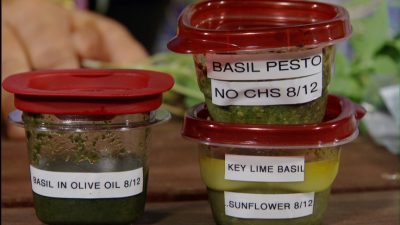Freezing Herbs for Year Round Use

by Trisha Shirey
Some herbs are seasonal, even in the mild climate of central Texas, and I miss cooking with basil too much to part with it altogether in the winter months. Basil loses its flavor as a dried herb, so freezing if the method I prefer to use to preserve it.
Other herbs which die back seasonally are dill, cilantro, chervil and parsley. They can be difficult to keep alive in the summer months so are worth freezing since they don’t dry very well. Lemon balm, lemon verbena and Mexican marigold die back in winter so they deserve a bit of freezer space. Chives, tarragon, marjoram, savory, oregano and mint may be preserved in this way also but we generally have those throughout our winter.
The simplest way to freeze herbs is to pick them, rinse and dry on a towel and then remove the leaves from the stems and place on a tray in a single layer. Freeze them for about thirty minutes and then place in small labeled containers.
Freezing them in a single layer first prevents them from ending up in a large clump that is difficult to separate. You will want to avoid having much air space around them in the container to prevent frost damage. The color may darken a bit, but the flavor stays intact.
Simply take out the leaves as needed and crush them immediately while still frozen to add to soups, stews, casseroles and sauces as needed. They may also be minced finely after they thaw a bit.
Herbs may also be preserved in oil or butter. This method requires a bit more work to prepare but the color and flavor are much superior.
To prepare:
- Add 1 1/2 to 2 cups of clean, dry herb leaves to a food processor. Pulse to chop coarsely and drizzle in 1/2 cup olive oil (or oil of choice) or one stick of butter, cut into chunks.
- Process, scraping bowl frequently. Add garlic or lemon juice if desired.
- You should have a thick paste that is relatively smooth. Add more oil or herbs to create the desired consistency.
You can store small amounts for cooking in plastic or glass containers. I find that two ounce portions are about right for pasta, pizza topping or to mix with some steamed vegetables.
Mix herbs together in the oil that you might use together in cooking. Basil, oregano and thyme oil will make a flavorful soup or sauce and having them mixed together is a time saver.
I also like to put the oil or butter in labeled zip lock freezer bags and smash them flat. I keep a stack of assorted oils and butters in bags inside a plastic container to protect them. Take out a bag and cut or break off the amount you need.
Some cooks like to put the oil or pesto in ice cube trays, freeze them and pop out the cubes to place in baggies for use as needed. Make sure to store these in the center of your freezer so the defrost cycles don’t turn them into a large frozen glob.
You can also make pesto with basil and other herbs and freeze it but leaving out the nuts and cheese makes the products more versatile for recipes. Add a bit to a vinaigrette, soup or pasta sauce.
Small amounts of herb butter added to cooked vegetables elevates them to gourmet status. Try mint butter on peas or corn, basil butter on green beans or marigold mint butter on corn. Top chicken or fish with herbed oil or butter before baking. I usually freeze butters, oils and pesto to cover all the bases!
The flavor will be best if used within six months. By that time your plants should be back in season to use fresh from the garden.
Another option for preserving herbs is making herbal vinegars.
Article Type: How To
categories:
tags:
related:
appeared on episodes:

 Trisha Shirey
Trisha Shirey